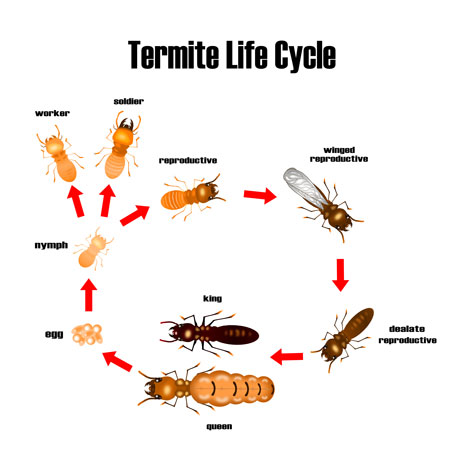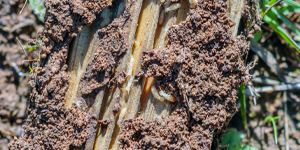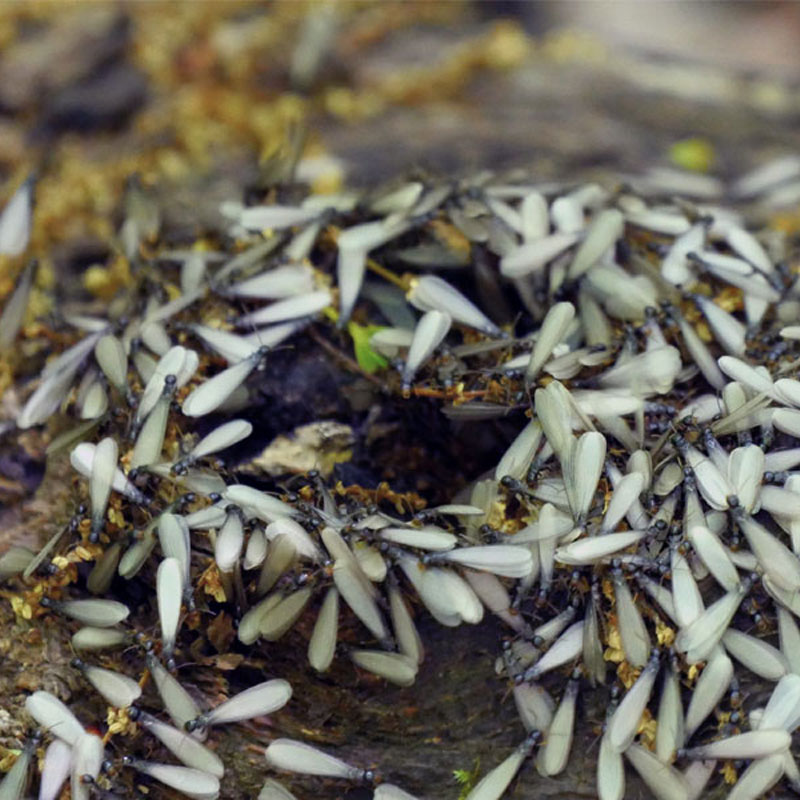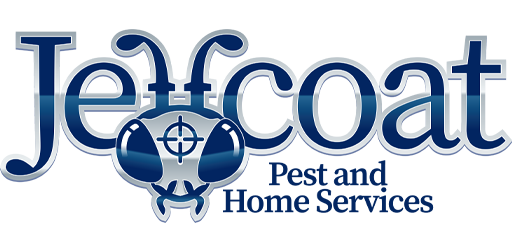Understanding Termites:
Their Life Cycle and Habits
As homeowners, we often find ourselves at odds with pests that threaten our homes. Of these unwelcome guests, termites are particularly notorious, and here in the south they are a constant threat. By understanding the life cycle and habits of these household pests, we are better able to identify termite infestations and implement termite control measures.
Life Cycle of a Termite
A termite’s life stages can be broken down into various stages from reproduction to adult termite. The lifespan of termites ranges from a few years to several decades, depending on the role and the species of the termite.
Reproduction
The life cycle of a termite begins with a swarming flight. Reproductive termites, also known as alates or swarmers, take to the air to find a mate and start a new colony. After finding a suitable mate, the pair shed their wings, mate, and then dig into the soil to start their new colony.
Egg
Termite eggs are small, usually about one millimeter in diameter, and translucent to creamy white in color. They can often be found in clusters within the termite colony, typically near the queen in a special chamber designed for reproduction.
The queen starts laying eggs a few days to a few weeks after her nuptial flight, often producing just a handful of eggs per day. As she matures, her egg-laying capacity significantly increases, with some mature queens capable of laying thousands of eggs each day.

Queen Termite
The queen termite has the primary role of reproduction in the colony. Over time, she becomes larger as her egg-laying capabilities increase. In some species, mature queens can reach a size many times larger than other colony members.
Nymphs / Larvae
The eggs hatch into nymphs, which are essentially baby termites. Termite nymphs will molt several times before becoming mature termites and deciding on a caste – that is, whether they will become worker, soldier, or reproductive termites.
Note: Sometimes nymphs may be referred to as termite larvae.
Termite Castes
Termites are social insects that form massive colonies. Termite colonies are organized in a caste system, with each type of termite having specific roles within the colony.
Worker Termites
These are the termites that cause damage to homes. Worker termites are responsible for taking care of the needs of the colony and their jobs involve foraging for food, caring for the young, and building tunnels and galleries. They are typically white and do not have wings. In some species of termite, worker termites are regarded as a specialized type of larva, as they do not have eyes, wings, or reproductive organs.
Termite workers feed on cellulose, the main component in plant material and, most notably for homeowners, wood. They have unique, symbiotic microorganisms in their guts that allow them to digest cellulose, which other animals cannot do. They also share this digested cellulose with the rest of the colony through a process known as trophallaxis, effectively feeding the entire colony.
Soldier Termites
As the name suggests, soldier termites are responsible for defending the colony. They have large heads and powerful jaws, called mandibles, designed for this purpose. These termites are so heavily specialized that in most termite species they are unable to feed themselves and are dependent on worker termites for their survival.
Reproductive Termites
Also known as alates or swarmers, these termites have wings and are responsible for starting new colonies. In most colony forming insects (like ants and bees), the male dies soon after mating. Termites are different, and both male and female reproductive alates (king and queen) mate for life.
Once a mated pair has started a colony they will never leave it. New colonies are started by their offspring, when young termite alates take flight in swarms to find a new mate and start the cycle anew. If the termite queen dies, a termite king can release pheromones which encourage the colony to produce secondary reproductive females.
Types of Termites
Termites may all seem similar to the untrained eye, but in reality, there are nearly 3,000 known species globally. These species can be categorized by their nesting preferences:

Subterranean Termites
Subterranean termites are the most common and arguably the most destructive termite species found in the United States. As their name implies, they live underground, building expansive colonies that can house millions of termites. They construct distinctive “mud tubes” to reach food sources and protect themselves from open air. Subterranean termites feed primarily on cellulose material including wood, but also paper, fiberboard, and even some types of fabric. Their ability to consume these materials and their large colony size make them a significant threat to homes, resulting in billions of dollars in damage each year.

Drywood Termites
Drywood termites, as you might guess from the name, prefer dry wood and do not require contact with the soil, unlike their subterranean counterparts. They infest dry wood, such as the structural wood in homes, utility poles, and furniture. They’re often introduced into homes when infested furniture or other wooden objects are brought inside. Drywood termite colonies are typically much smaller than subterranean termite colonies, but they can still cause considerable damage. They leave behind characteristic pellets called frass, a clear sign of infestation. Drywood termites are most common in southern states and coastal areas.

Dampwood Termites
Dampwood termites are usually larger than other termite species and, as the name suggests, they prefer to feed on very moist wood. Because of this, they are less likely to infest buildings unless there are serious moisture problems. They usually infest rotten wood, logs, stumps, and dead trees. Dampwood termite infestations are typically easier to detect than other species due to their preference for extremely damp wood. Signs of an infestation can include damaged wood that appears clean and smooth inside.
What is a termite swarm?
A termite swarm occurs when winged reproductive termites, or swarmers, leave their colony to start a new one. This is often the most visible sign of a termite infestation.
Even if the swarm itself is not seen taking place, the shed pairs of wings are a clear sign of termites. If you encounter clusters of insect wings then it is important to get a termite inspection ASAP – a colony that is able to produce swarms is mature and can cause significant damage to wooden structures in very little time.
Why do termites swarm?
Termites swarm to reproduce and spread their new locations. Swarming is a critical phase in the termite life cycle as it allows them to find mates and establish new colonies, thereby ensuring the survival and spread of their species.

When do termites swarm?
The timing of termite swarms varies by species and geography, but most termites swarm during the warmer months of the year, especially in spring or early summer. Some species may also swarm in the fall. Regardless of the time of year that termites swarm, they generally wait for overcast conditions with little wind, after it has recently rained.
How long do termites live?
Termite lifespan varies by caste. Worker and soldier termites typically live one to two years. The reproductive termites (king and queen) have significantly longer lifespans, often living for a decade or more. There are records of termite queens living up to fifty years, making them among the longest-lived insects.
Knowing Your Enemy: Termites
Understanding the termite life cycle and habits is the first step to effectively managing and preventing termite infestations. Remember, the best defense against termites is a good offense, which means taking preventative measures to ensure these pests can’t get a foothold in your home.
If you suspect a termite infestation, it’s best to consult with a professional pest control service to assess and handle the situation. With a solid understanding of termites, you can better protect your home from these wood-eating pests.
